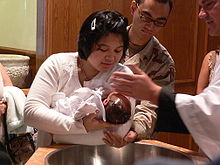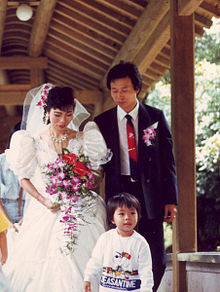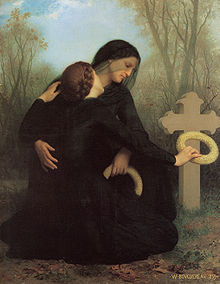- Ceremonial clothing in Western cultures
-
Not to be confused with Ceremonial dress.
Ceremonial clothing in Western cultures, life cycle celebrations associated with particular occasions are manifested by certain types of ceremonial clothing. Some events where ceremonial clothing would be worn include baptism, graduation, marriage, and mourning.
Contents
Birth
Many people adhering to Western religions welcome a new-born child into the congregation or the community with a special ceremony, such as baptism for Christian children or a bris for Jewish males in religious families. Adult participants may wear clothing appropriate for religious occasions. The child, in the Christian case, often wears a special christening robe. This white dress, worn by both males and females, is typically extremely long, so that the hem of the dress extends a meter or more past the infant's feet. The adult holding the child to be christened arranges the hem so that it falls free. The hem may be lavishly decorated with lace and embroidery. The christening robe thus serves as a display of wealth and status. Families may carefully preserve a christening robe to be used by several generations of infants.
Leaving nursery status
Until the late 19th century, young Western boys and girls often wore the same attire: a dress. Unisex infant clothing made changing diapers easier and simplified the passing of garments from one child to the next. When a young boy had reached an age at which he could begin to train in manly pursuits, he would be dressed in pants rather than dresses. Before the 19th century, his clothing might be simply a miniature edition of adult wear. During the 19th century, men wore long pants and boys wore short pants.
In current Western societies, even infant clothing may be marked for gender, and there is no such transition as the donning of the first pair of pants.
Reaching adult status
Some Christian churches welcome children reaching "the age of reason" into the congregation as adults in the ceremony of confirmation. Girls being confirmed typically wear pristine but modest white dresses; boys may wear suits or other formal attire. In the Catholic church, where the child may receive both First Communion and somewhat later, Confirmation, the attire is similar for both sacraments.
In 19th century England, coming of age was also marked by a boy's wearing long pants instead of short ones, and girl putting up her hair, in a bun or chignon , rather than wearing it loose down her back or in schoolgirl braids.
In 18th and 19th century England, a well-brought-up girl was either "out" -- admitted to adult social occasions—or "not out". Starting in the 18th century, it became customary to mark a girl's "coming out" with a special festivity, such as a ball in her honor. Wealthy families spent great sums of money on elaborate clothing, decorations, food and drink, etc. Late in the 19th century, it became more common for wealthy families to club together to sponsor a ball or cotillion at which many girls "came out" together, or made their debut. They were called debutantes.
Debutantes wear ball gowns, of course, but usually ones of restrained cut and coloring that suggest a modest girl being introduced to society for the first time.
Most Western girls are not debutantes; that is reserved for girls of a certain class and wealth; however, more girls have sweet sixteen parties which may involve formal dresses.
For Latin Americans, however, the debut is still a major occasion. It is called the quinceañera and held on the 15th birthday. Even the poorest families will spend large sums on a lavish dance, often held in a rented hall. The girl being honored typically wears a pink dress.
Graduation
See also: Academic dressWestern universities took shape during the Middle Ages and still retain many vestiges of medieval custom. One of those vestiges is scholarly attire: gowns, caps, and hoods, as worn hundreds of years ago. Once worn for all lectures and other public occasions, the cap and gown is now usually reserved for university graduation ceremonies.
Ordinary bachelors, or holders of B.A., B.Sc., etc. degrees, wear a black gown over their ordinary clothes and a cap called a mortarboard, consisting of a stiff square panel sewn onto a skull-cap and a hood. Higher degrees call for scarlet or coloured gowns.
In the 19th century in the United States, the bachelor's gown and mortarboard were annexed by the new institution of the high school. Today, even kindergartners may graduate using miniature caps and gowns.
Marriage
A man marrying is a groom. In the US, he typically wears a suit, or other formal wear, such as morning dress, white tie, evening wear (a "tuxedo"), or kilt. A woman marrying is a bride and most often wears a wedding dress or wedding gown.
For a first-time bride, the dress is usually white. Women marrying for the second (or third, or fourth) time are supposed to forgo the elaborate white gown and wear an off-white or other colored dress or ensemble. Women other than the bride are not supposed to wear white or black to a wedding, as white is reserved for the bride, and black for funerals.
There is some dispute as to whether the white dress is a claim to virginity, or lack of sexual experience, or simply to modesty and purity. Some people would claim that a non-virgin should not wear a white gown (thus leading to malicious gossip regarding a bride's presumption in wearing white). Others say that it simply means "first marriage" and can be worn by any woman, even if she has been co-habiting with her fiancé(e) for years. This latter view is increasingly the norm, and in line with modern etiquette.
The archetypal wedding gown is cut like a ball gown, with a wide skirt, tight waist, and decolletage. If the skirt is cut closer to the body, it may still have a trailing train, often carried by a child trainbearer. The dress is accessorized with a lace veil, often anchored by a tiara and a bouquet of flowers, often encased in an elaborate bouquet-holder. Brides' gowns may be long and more formal the dress of the rest of the wedding party, regardless of the style of wedding or time of day.
Brides customarily wear, in the words of an old jingle:
- Something old and something new,
- Something borrowed and something blue,
-
- and in the British version, a last verse:
- and a lucky sixpence in her shoe.
Because wedding apparel is often quite expensive, most brides find no difficulty in mixing old and new. A new dress will be crowned with a family heirloom veil, an old dress with new earrings, etc. The borrowed item is often a handkerchief; the blue item is often a garter. The garter is a decorated band of elastic once used to hold up long stockings. Garters are no longer used to hold up stockings, but survive in many weddings as an item that the groom removes during the reception and throws to the single men, though this custom is falling out of favor.
The elaborate and expensive white wedding dress is an innovation of the 19th and 20th centuries. It is increasingly a component of wedding ceremonies in all parts of the world, often in parallel with non-Western costumes and customs. For example, Japanese brides may now dress several times, in the traditional Japanese wedding costumes, then appear again in a Western wedding gown.
Death
See also: Mourning dressThe dead are honored with a funeral and often a reception or a wake following. Anyone attending the funeral is expected to wear black or at least sombre or drab-colored clothing. A widow may wear a black veil over her face.
Following the funeral, family and friends now resume their normal clothing. This is a modern innovation. Until the late 19th and early 20th centuries, relatives were expected to wear mourning for periods that varied depending on the closeness of their relation to the deceased. The rules for mourning wear were strict and complicated. They may only have been observed in their entirety by the wealthy with money and time for a course of mourning that started with black clothing, progressed to grey, then violet, and ended with the wearing of colors again. The poor might just wear a black armband over their regular clothing as a sign of mourning.
Mourning bore heaviest on the widow. In many Mediterranean countries, she might wear black for the rest of her life. In England, she wore a cumbersome outfit called widow's weeds: an all-black dress surmounted with a widow's cap trailing a long black veil.
Categories:- History of clothing (Western fashion)
- History of clothing (Europe)
- Ceremonial clothing
- Religious vesture
Wikimedia Foundation. 2010.




